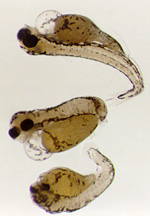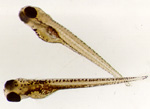Mentoring lures high schooler into research
by Dick PetersonPublic Relations
Gig a frog in Minnesota and you just might get a surplus of frog legs— or a frog with just one eye, or even a deformed spine. It's an unsettling thought that these delicate creatures may be harbingers of environmental damage that could cause similar deformities in humans.
Claudia
Wilburn
That's the thought that teamed Hanahan High School junior Claudia Wilburn with MUSC pharmaceutical sciences professor G. Patrick Meier, Ph.D., and enlisted the help of College of Charleston professor Denise Smith, Ph.D. With the support of Hanahan High School science teacher, Norma Ashburn, they helped Wilburn launch a research project to explore the effects of the mosquito abatement insecticide, methoprene, on frog embryos.
Her research placed second in the senior division of the Lowcountry Science Fair held at the College of Charleston and first place in zoology for her oral presentation at the South Carolina Junior Academy of Science held at Lander University.
She faced a problem, however—no frogs. They were out of season in December.
“But zebra fish can be grown year-round, so we used zebra fish,” Meier said. That's when he enlisted Smith's help. She runs a College of Charleston national fisheries lab at Fort Johnson and had all the zebra fish they needed.
“Claudia did an excellent job of putting the project together,” Meier said. “She came up with the general topic and designed the experiments.” First she read the scientific literature covering the chemical and biological factors relating to her project, and then proceeded with the experiments.
Once it was determined that methoprene had no effect on the zebra fish embryos, she began looking at photoproducts of methoprene—the environmental degradation products that develop as the chemical is exposed to sunlight and water.

 Exposure
to degraded products of an insecticide produced deformities in zebra fish
embryos (top) normal embryos (bottom) are shown for comparison.
Exposure
to degraded products of an insecticide produced deformities in zebra fish
embryos (top) normal embryos (bottom) are shown for comparison.
Wilburn first exposed the zebra fish eggs to the degraded products of methoprene. She then removed them from the chemicals and incubated them to let them grow. At various stages of growth, she dissected out the fish embryos from the eggs and examined them under a microscope for fetal deformities. She found malformed and misplaced fins, and heart, spine and eye deformities.
Meier, who chairs the South Carolina Section of the American Chemical Society, has worked with several serious high school students to develop their interest in biomedical research.
“Claudia's teacher and I co-wrote a grant once, and she knew I'd help. And I knew with her support on one side and mine on the other, Claudia would get through this project.” Meier said that academic and social pressures are heavy on a high school student, and staying with a research project is difficult.
In all, Wilburn had to expose, incubate and dissect hundreds of fish embryos to complete her project. Meier said that the tedium of data collection hit her hard and there were times she didn't want to continue the research. “But that's just the nature of science,” he said.
A sentence in Wilburn's thank-you note to Meier makes him smile: “Should I choose to extend the project, your continued guidance would be appreciated,” she wrote. Meier expressed satisfaction in reporting that since her letter she has contacted him and does want to proceed with the next phase of her project in the fall.
;“The work went well, and it looks like we've hooked another promising young person into a very exciting field,” Meier said.